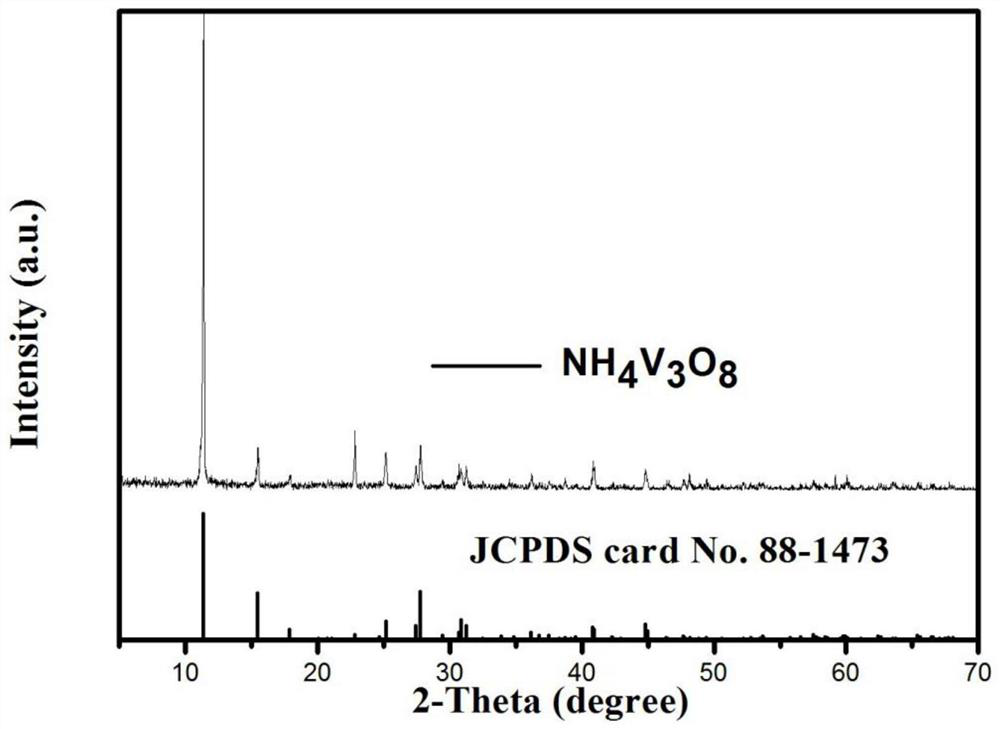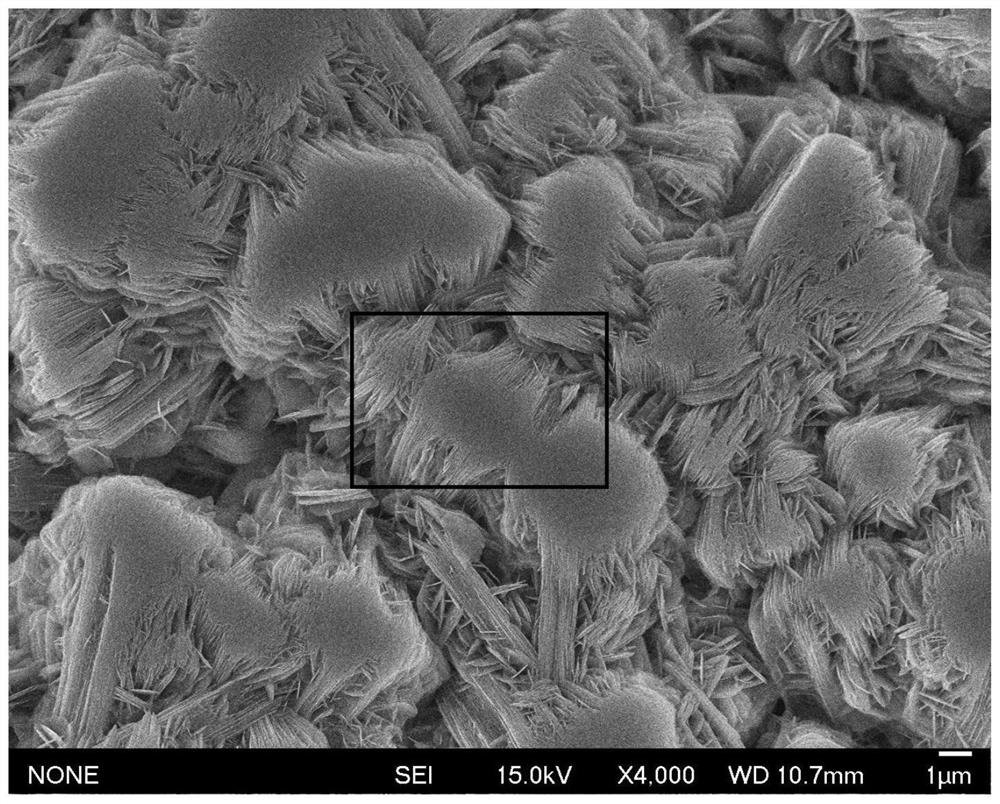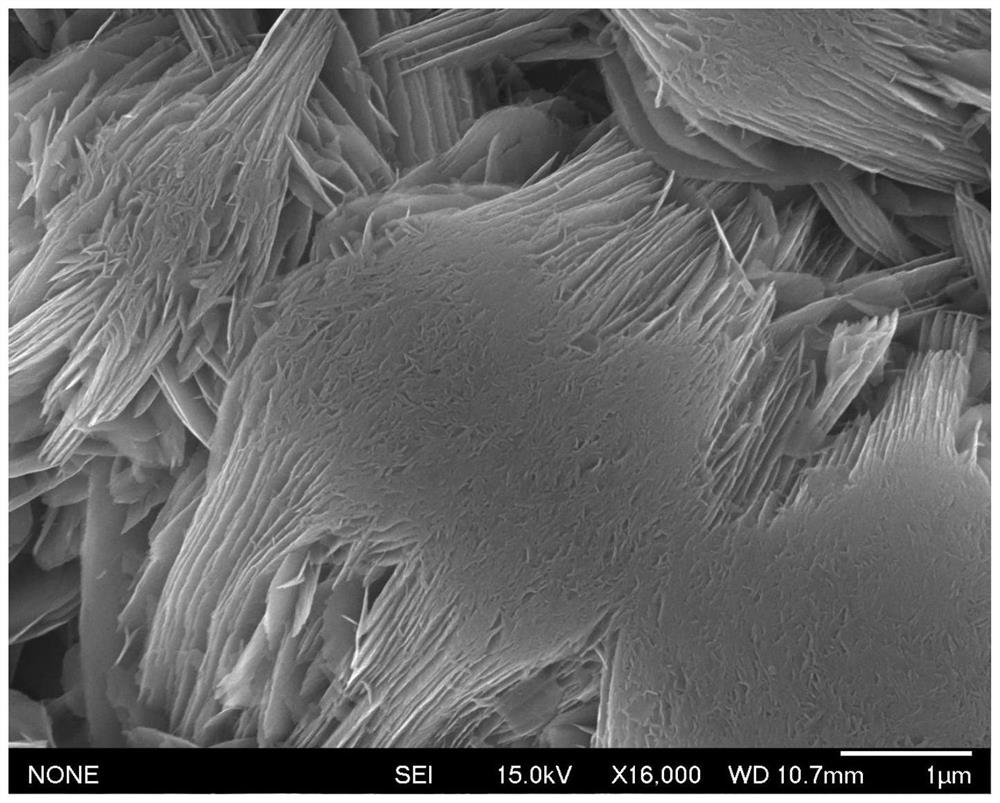A method for preparing ultra-thin nanosheet-shaped nh4v3o8 nanomaterials by ultra-high pressure
A nano-sheet, nano-material technology, applied in nanotechnology, nanotechnology, chemical instruments and methods, etc., can solve the problems of unreported nanosheets, achieve environmental protection in the preparation process, short diffusion paths, and improve the electrochemical window. Effect
- Summary
- Abstract
- Description
- Claims
- Application Information
AI Technical Summary
Problems solved by technology
Method used
Image
Examples
Embodiment 1
[0027] A kind of ultra-high pressure preparation of ultra-thin nanosheet NH 4 V 3 o 8 A method for nanomaterials, comprising the steps of:
[0028] Step 1: Dissolve 0.08g of 1-methyl-3-ethylimidazole chloride in 10mL of water, then add 0.05g of ethylenediaminetetraacetic acid and stir to form a mixed solution;
[0029] Step 2: Add 5mL of ethylene glycol with a volume fraction of 50% to the mixed solution and then add 0.3g of NH 4 VO 3 and heated to make NH 4 VO 3 fully dissolved NH 4 VO 3 solution; wherein, the heating temperature is 50°C;
[0030] Step 3: Add NH 4 VO 3 The solution was microwaved in a microwave oven for 3 minutes; wherein, the power of the microwave oven was 500W;
[0031] Step 4: Microwave the NH 4 VO 3 The solution was transferred to a reaction kettle lined with polytetrachlorethylene and placed in a micro ultra-high pressure hydrothermal reactor for hydrothermal reaction at 140°C for 6 hours to obtain a suspension; wherein, the pressure in the...
Embodiment 2
[0035] A kind of ultra-high pressure preparation of ultra-thin nanosheet NH 4 V 3 o 8 A method for nanomaterials, comprising the steps of:
[0036] Step 1: Dissolve 0.15g of 1-methyl-3-ethylimidazole chloride in 10mL of water, then add 0.1g of ethylenediaminetetraacetic acid and stir to form a mixed solution;
[0037] Step 2: Add 10 mL of glycerol with a volume fraction of 50% to the mixed solution and then add 0.5 g of NH 4 VO 3 and heated to make NH 4 VO 3 fully dissolved NH 4 VO 3 solution; wherein, the heating temperature is 40°C;
[0038] Step 3: Add NH 4 VO 3The solution was microwaved in a microwave oven for 4 minutes; wherein, the power of the microwave oven was 600W;
[0039] Step 4: Microwave the NH 4 VO 3 The solution was transferred to a reaction kettle lined with polytetrachlorethylene and placed in a micro ultra-high pressure hydrothermal reactor for hydrothermal reaction at 150°C for 4 hours to obtain a suspension; wherein, the pressure in the micro...
Embodiment 3
[0042] A kind of ultra-high pressure preparation of ultra-thin nanosheet NH 4 V 3 o 8 A method for nanomaterials, comprising the steps of:
[0043] Step 1: Add 0.2g of 1-methyl-3-ethylimidazole chloride to 10mL of water to dissolve, then add 0.1g of ethylenediaminetetraacetic acid and stir to form a mixed solution;
[0044] Step 2: Add 6 mL of methanol with a volume fraction of 50% to the mixed solution and then add 0.43 g of NH 4 VO 3 and heated to make NH 4 VO 3 fully dissolved NH 4 VO 3 solution; wherein, the heating temperature is 30°C;
[0045] Step 3: Add NH 4 VO 3 The solution was microwaved in a microwave oven for 2 minutes; wherein, the power of the microwave oven was 700W;
[0046] Step 4: Microwave the NH 4 VO 3 The solution was transferred to a reaction kettle lined with polytetrachlorethylene and placed in a micro ultra-high pressure hydrothermal reactor for hydrothermal reaction at 170°C for 5 hours to obtain a suspension; wherein, the pressure in th...
PUM
 Login to View More
Login to View More Abstract
Description
Claims
Application Information
 Login to View More
Login to View More - R&D
- Intellectual Property
- Life Sciences
- Materials
- Tech Scout
- Unparalleled Data Quality
- Higher Quality Content
- 60% Fewer Hallucinations
Browse by: Latest US Patents, China's latest patents, Technical Efficacy Thesaurus, Application Domain, Technology Topic, Popular Technical Reports.
© 2025 PatSnap. All rights reserved.Legal|Privacy policy|Modern Slavery Act Transparency Statement|Sitemap|About US| Contact US: help@patsnap.com



